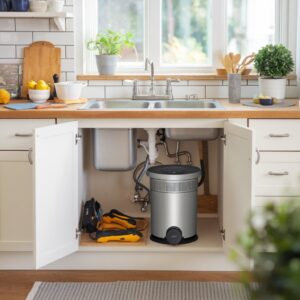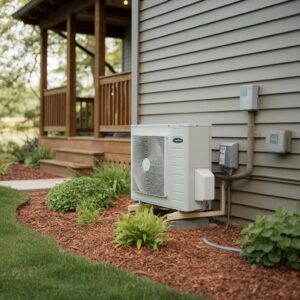Plumbing tape, or PTFE tape, is essential for sealing threaded pipe joints. If you’re looking for everything you need to know about using it properly, the key is to wrap it clockwise around clean, dry threads, overlapping each wrap by half its width. Apply three to four layers, maintaining tape tautness and guaranteeing a wrinkle-free application. Different tapes, like yellow for gas or pink for high-pressure, cater to specific uses. A professional’s insight can optimize your plumbing project further and secure a leak-proof system.
Key Takeaways
- Wrap plumbing tape in a clockwise direction to match the threading direction and prevent leaks.
- Apply three to four layers of tape with a taut and half-overlapping technique for a robust seal.
- Ensure the tape is smooth without wrinkles or gaps to maintain a watertight seal.
- Clean threads thoroughly before applying new tape, removing any remnants from old applications.
- Consider professional help for complex systems or when handling female fittings to ensure proper application.
What Is Plumbing Tape and How Does Tape Work?
Plumbing tape, commonly known as PTFE tape or Teflon tape, is a non-adhesive film used extensively in threaded pipe joint assembly to enhance sealing performance and prevent leakage. Plumbing tape is a simple yet highly effective solution that fills the micro-voids present in threaded connections, thereby creating a watertight seal through mechanical compression and material deformation.
The industry recognizes several types of tape, including standard Teflon tape and specialty variants such as gas-rated or high-density PTFE, each designed for specific application requirements.
Understanding the Basics of Plumbing Tape
In fluid dynamics applications, PTFE, commonly known as tape or thread seal tape, serves as an essential sealing material that enhances joint integrity. If you need to know about plumbing tape and tape has many uses, it’s important to understand that this non-adhesive, chemically inert Teflon tape is indispensable in creating effective seals on pipe threads. When professionals wrap the tape around a threaded pipe, its malleability allows it to conform precisely to the surface irregularities, facilitating a watertight seal. The application process involves wrapping the tape clockwise around the male pipe thread and then tightening the tape to guarantee a snug fit.
| Term | Description | Usage |
|---|---|---|
| Plumbers Tape | Synonym for plumbing tape | Used for sealing threaded joints |
| Pipe Thread | Spiral ridge on pipes | Guarantees mechanical fit and seal |
| Watertight Seal | Impermeable barrier created by thread seal tape | Prevents leaks in fluid systems |
How Does Plumbing Tape to Create a Watertight Seal?
An essential component in guaranteeing a watertight seal in plumbing systems is PTFE tape‘s ability to fill the microscopic voids between threads.
Plumbers tape, also known as thread-seal tape, secures a tight seal by conforming to the contours of threaded pipe connections. By wrapping the tape around these connections, it minimizes the risk of leaks.
Plumbing tape is designed to be non-reactive and flexible, which allows it to maintain its integrity under pressure. To achieve an ideal seal, it is important to wrap the plumbing tape around the pipe connection, aligning with the direction of the threads.
This technique prevents unraveling during assembly, thereby facilitating a leak-free joint. The proper application guarantees a reliable, watertight seal in various scenarios.
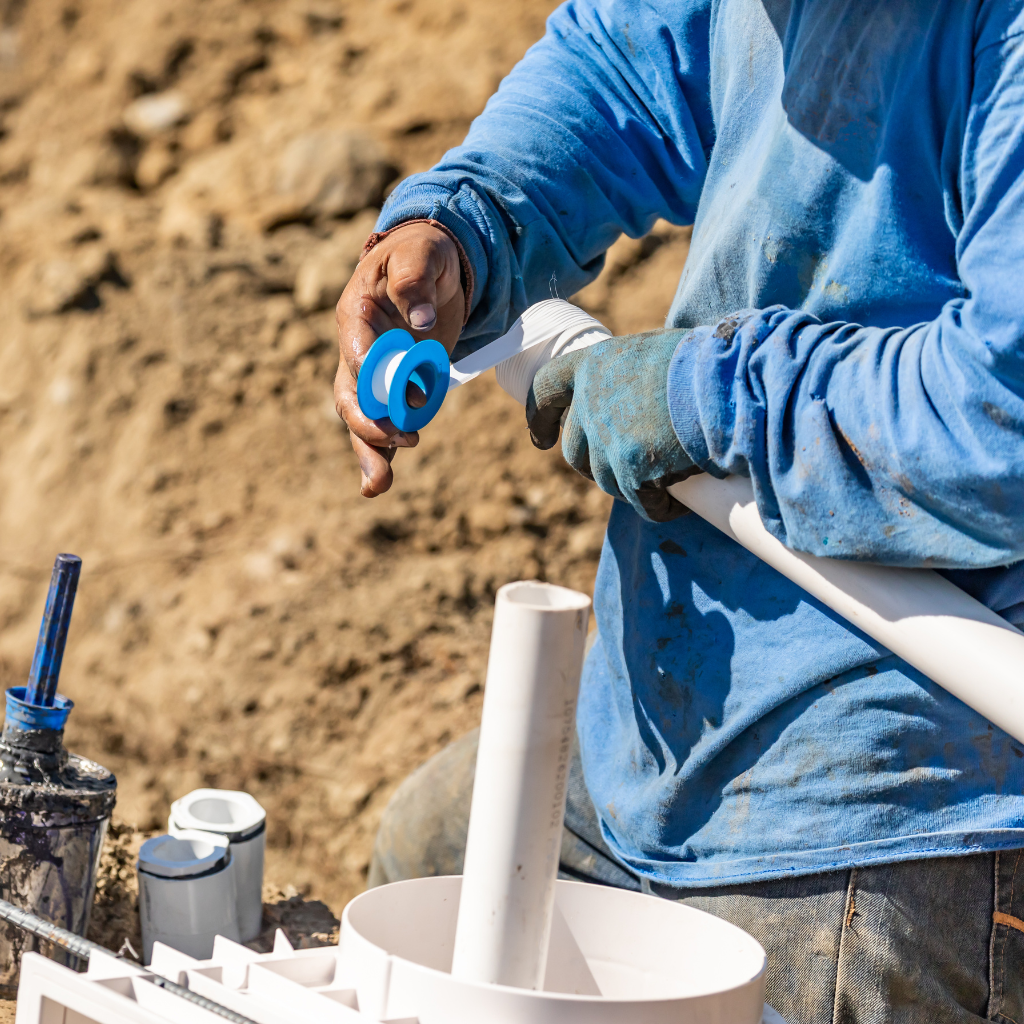
Common Types of Plumbing Tape: Teflon Tape and More
Understanding the mechanics of a watertight seal necessitates exploring the various types of tapes available. Plumber’s tape, also called Teflon tape or thread seal tape, is essential for effective connections. Selecting the right plumbing tape guarantees a secure seal, preventing leaks in systems.
- Standard White Tape: Ideal for water lines, this Teflon tape is wrapped around the threads to achieve a watertight seal.
- Yellow Gas Pipe Tape: Specifically engineered for gas pipe connections, providing enhanced density and reliability.
- Pink Tape: Used for high-pressure water systems, offering durability.
- Green Tape: Designed for oxygen lines, avoiding potential contamination.
Choosing the appropriate type of tape is vital. Each variant caters to specific applications, safeguarding the integrity of plumbing systems.
How to Use Plumbing Tape Correctly
Proper application of plumbing tape, also known as PTFE tape, is critical for ensuring a leak-free seal on pipe threads. When plumbing tape is used correctly, it helps prevent leaks by filling gaps between threaded connections.
Common errors, such as wrapping the tape in the incorrect direction or using insufficient layers, can compromise the integrity of the joint.
To guarantee a tight seal, practitioners should wrap the tape clockwise around the male threads, typically applying three to four layers, ensuring full coverage without overlapping onto the pipe itself.
Common Mistakes When Using Plumbing Tape
Grasping the nuances of plumbing tape application is essential to guaranteeing leak-free connections. However, several common mistakes often compromise its efficacy:
- Incorrect Direction: Failing to wrap it around the thread in the same direction as the fitting rotation results in unravelling when tightened. Always tape in the same direction.
- Excess Tape: Applying too much tape leads to uneven surfaces, preventing the creation of a watertight seal. Use 2-3 wraps for best results.
- Insufficient Coverage: Not covering the entire thread limits the tape’s sealing capacity. Guarantee full coverage to avoid leaks.
- Reusing Tape: Attempting to reuse old tape undermines integrity. Remove the tape and applying the plumbing tape correctly with new material for each installation.
Understanding and correcting these pitfalls is pivotal for effective plumbing tape usage.
Tips for Ensuring a Tight Seal on Threaded Pipe
After identifying common pitfalls in plumbing tape application, practitioners can enhance seal integrity by mastering specific techniques.
Guaranteeing a tight seal on pipe threads requires precise application, often referred to as Teflon tape or plumber’s tape. Begin by thoroughly cleaning the threaded plumbing connections to eliminate debris.
When using thread seal tape, start at the end of the pipe, wrapping the tape around the threads in the direction of the thread turn, typically clockwise. This orientation prevents unraveling during assembly.
For maximum coverage, overlap the tape by 50% with each wrap, applying three to four layers. This technique guarantees robust sealing, which is fundamental for leak prevention in plumbing projects.
Proper application and knowing how to use the tape around the threads is vital for maintaining leak-proof integrity.
Choosing the Right Plumbing Tape for Your Project
Selecting the correct plumbing tape is critical for ensuring a leak-proof seal and maintaining the integrity of the piping system.
For gas pipes, yellow Teflon tape is mandatory due to its gas-tight properties, while plumber’s tape, often white or pink, is more suitable for water applications.
Understanding the color-coded system—white for standard, pink for water, and yellow for gas—enables a precise match between tape type and project requirements.
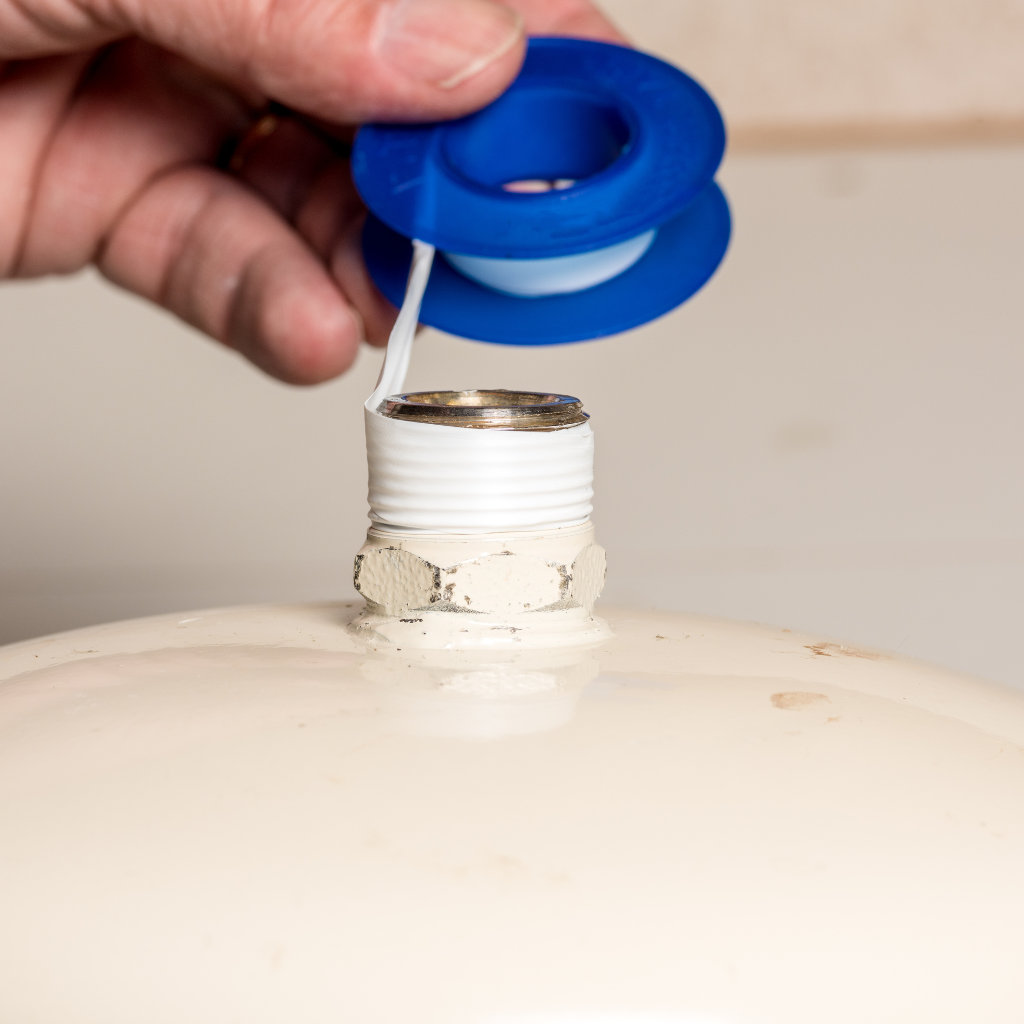
How to Select the Correct Tape for Gas Pipes
The right tape guarantees leak-proof seals, essential for safety and functionality. When dealing with gas pipes, utilizing the appropriate is vital. Pink tape, specifically engineered for gas pipes, offers robust sealing strength. Identifying the right tape involves understanding its compatibility with plumbing tools and fixtures.
Here’s a guideline for choosing the correct tape:
- Material Compatibility: Verify the tape is suitable for gas pipes, preventing leaks.
- Colour Coding: Use pink tape for gas applications; it’s thicker than standard Teflon tape.
- Tape Density: Select high-density thread tape to enhance seal integrity.
- Tape Application: Proper application guarantees the tape work is effective, securing the plumbing fixture.
Choosing wisely prevents hazardous mishaps.
When to Use Plumber’s Tape vs Teflon Tape
Plumber’s tape, a category encompassing various thread seal tapes, is essential for sealing threaded pipe connections. Teflon tape, a type of white tape, is particularly favoured for water and air pipe threads due to its low-friction properties. When wrapping tape around threads minimizes the likelihood of cross-threading, enhancing joint integrity. Teflon tape acts as a lubricant, allowing threaded parts to tighten with precision, effectively mitigating plumbing problems.
Conversely, plumber’s tape, often broader, is utilized for its universal adaptability in sealing pipe joints. Selecting the appropriate plumbing tape, whether general plumber’s or specific Teflon, directly influences the efficacy of sealing and longevity of the installation.
Understanding the Differences: White, Pink, and Yellow Tapes
While choosing the appropriate plumbing tape, understanding the color-coded applications is essential for guaranteeing ideal performance and durability in plumbing systems.
Different tapes serve specific purposes:
- White Teflon Tape: This standard thread seal tape is used for general plumbing applications. It’s vital for residential water lines, providing effective sealing around the threads.
- Pink Tape: This heavy-duty option is designed for high-pressure systems. Pink tape effectively seals around the threads in commercial and industrial applications.
- Yellow Tape: Specifically for gas lines, yellow tape offers enhanced density and durability, which is important for sealing threads in gas fittings.
- Understanding How to Use: Each tape must be wrapped around the threads in a clockwise direction to prevent leaks and guarantee optimal sealing performance.
Troubleshooting Plumbing Tape Issues
In addressing plumbing tape malfunctions, one must systematically tackle the removal and reapplication process to guarantee efficacy.
It is imperative to strip the existing tape cleanly from the threads, making certain no residual debris undermines the integrity of the seal.
Proper tape application, entailing uniform pressure and correct directional wrapping, is essential in mitigating leakage risks and guaranteeing a robust seal.
How to Remove and Re apply Plumbing Tape
Removing and reapplying plumbing tape, also known as thread seal tape or PTFE, is crucial for maintaining leak-free connections in threaded pipe fittings.
Here’s a step-by-step guide:
- Remove Old Tape: Begin by unthreading the pipe fitting and gently peeling off any existing standard white Teflon tape.
- Verify all remnants are cleared to avoid compromised sealing.
- Clean Threads: Use a wire brush to clean pipe threads, ensuring a smooth surface for the new application.
- Reapply Plumbing Tape: To use plumber tape effectively, cut the tape to a suitable length and wrap it clockwise around the pipe threads.
- Keep the tape taut and apply three to four layers.
- Tape Against the Threads: Apply consistent pressure, verifying the tape conforms tightly to the threads, enhancing the seal.
Preventing Leaks with Proper Tape Application
Achieving a leak-proof seal with plumbing tape hinges on meticulous application techniques and understanding potential pitfalls. Plumbers tape, commonly also known as Teflon tape, requires precise handling for maximum efficacy.
Begin by ensuring all old tape is thoroughly removed to prevent interference with the new application. Wrap the plumbing tape clockwise around the pipe threads, maintaining tautness to prevent slippage. Proper application entails overlapping each wrap by half the tape’s width, ensuring coverage without excess bulk. The end of the tape should be pressed firmly to secure adhesion.
To create a reliable seal, the tape must be applied smoothly and evenly without wrinkles or gaps. Understanding how to use plumbing tape effectively is essential for preventing leaks and ensuring joint integrity.
Professional Plumbing Tips for Using Plumber Tape
Professional plumbers emphasize the importance of maintaining consistent tension and overlap when applying plumbing tape to guarantee ideal thread sealing.
They recommend wrapping the tape clockwise around the threads, typically two to three layers, to prevent leaks and guarantee a snug fit.
In scenarios involving high-pressure systems or persistent leakage issues, it is advisable to engage a licensed plumber to assess and remedy the situation efficiently.
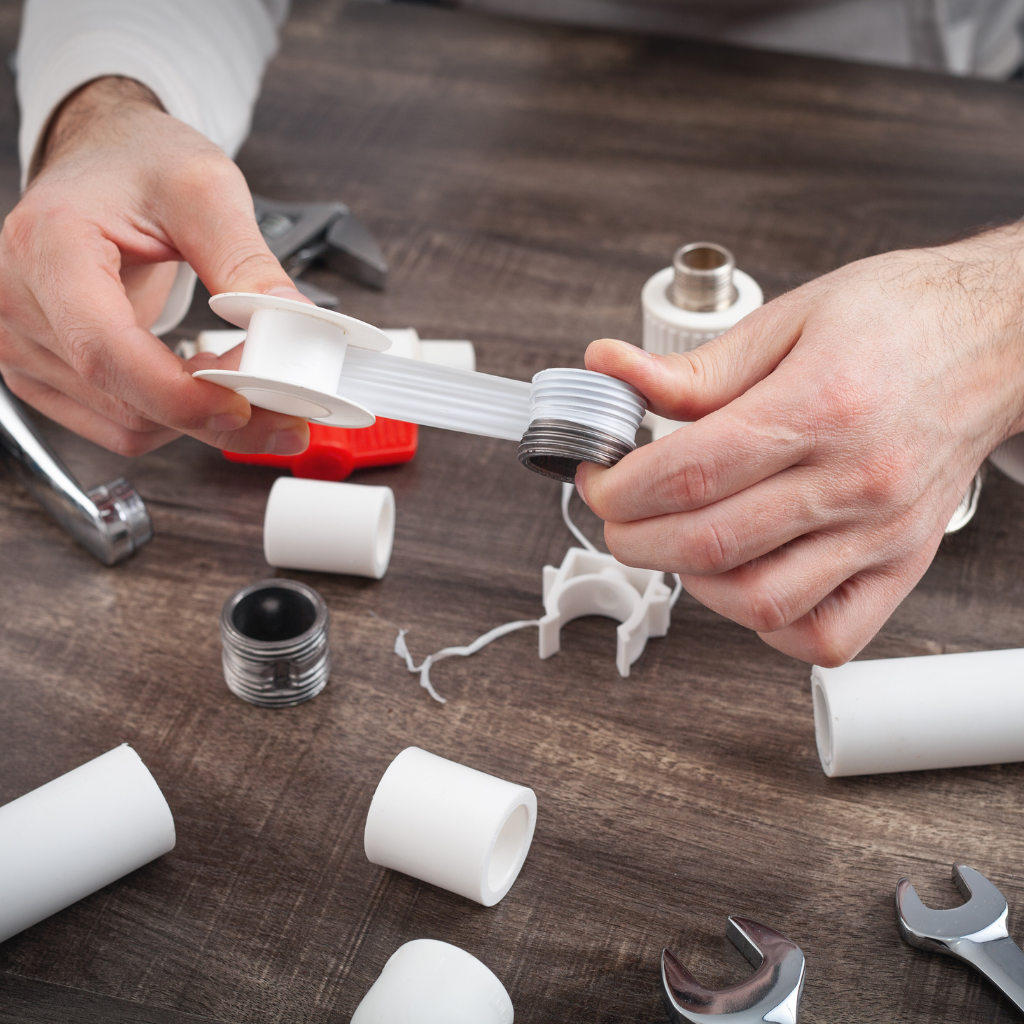
Plumber-Recommended Techniques for Wrapping Tape
Mastering the application of plumbing tape, or PTFE, involves adhering to specific techniques recommended by experienced plumbers to guarantee leak-free joints.
The proper use of plumber’s tape, often referred to as Teflon tape, is fundamental in professional plumbing to ascertain watertight seals. This tape is designed for threading applications where wrapping tape correctly is essential.
Plumber-recommended methods include:
- Clean Threads: Prior to apply the tape, verify all threads are free from debris and moisture.
- Direction: Wrap the plumber’s tape clockwise, mirroring the direction of the thread engagement.
- Layering: Apply two to three wraps of Teflon tape for standard applications, adjusting based on thread quality.
- Firm Application: Ensure snug, even tension while wrapping tape, preventing folds or overlaps.
These techniques optimize the sealing performance of plumbing tape.
When to Call a Professional Plumber for Assistance
How can one determine when it is prudent to enlist the expertise of a professional plumber for plumbing tape issues? Identifying scenarios requiring professional assistance is essential.
Complex plumbing systems, where proper use of Teflon tape is vital, often necessitate a plumber’s intervention. Engaging a professional becomes indispensable when plumbing issues transcend basic tape application, particularly with female plumbing fittings that demand meticulous precision.
A call to a plumber is warranted when improper tape application risks system integrity, leading to potential leaks or pressure failures. Furthermore, when troubleshooting plumbing tape failures without clear resolution, seeking expert guidance guarantees compliance with safety standards and maximum functionality.
Professionals possess the technical acumen for diagnosing and resolving intricate tape-related complications efficiently.
Conclusion
To summarize, mastering the application of plumbing tape, or PTFE, is essential for ensuring leak-free threaded pipe connections. Properly wrapping the tape clockwise around male threads, selecting the appropriate density tape, and recognizing the distinction between standard and gas-rated PTFE is fundamental. Troubleshooting involves examining tape integrity and reapplication if necessary. By adhering to these professional standards, plumbing practitioners can optimize sealing performance, mitigating potential leakage issues and enhancing system reliability.



